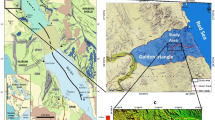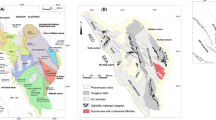Abstract
The processing of ASTER images’ band ratios 7/6*4/6 and (7 + 9/8) supported by field geology, mineralogical, and geochemical analyses enabled detection of two alteration zones as targets for gold exploration at Al Faw-Eqat belt (a case study in the eastern end of Wadi Allaqi). Representative samples were collected from the detected areas north of Gabal Eqat (area 1) and north of Gabal Al Faw (area 2) for geochemical analyses to assess the gold and associated metals. The result of atomic absorption and induced coupled plasma (ICP) analyses recorded Au content up to 9.8 g/t in the quartz veins and 7.8 g/t in the altered volcanics in area 1 while recorded 14.0 g/t in the quartz veins and 6.8 g/t in the altered volcanics in area 2. Al Faw-Eqat belt is made up of metamorphic and magmatic late Proterozoic rock assemblages. The metamorphics consist of ophiolitic ultramafics thrusted over the metavolcanosedimentary (mvs) rocks of meta-basaltic andesite composition forming highly tectonized sheared mafic and ultramafic belt extended in the NW/SE trend. The magmatic suite comprises syn- to late-tectonic calc-alkaline granites of less deformed tonalite and monzogranites that were intruded by post-tectonic potassic alkali feldspar granite of Gabal Eqat sending sheets, plugs, apophasis, and quartz veins in the surrounded mvs leaving marked of alterations of promised areas for gold exploration.










Similar content being viewed by others
References
Almond OC, Ahmed F, Shaddad MZ (1984) Setting of gold mineralization in the northern Red Sea Hills of Sudan. Econ Geol 79:389–392
Amer R, Kusky T et al (2010) Lithological mapping in the Central Eastern Desert of Egypt using ASTER data. J Afr Earth Sci 56(2–3):75–82
De Wall H, Greiling RO, Fouadsadek M (2000) Post-collisional shortening in the late Pan-African Hamisana high strain zone, SE Egypt: field and magnetic fabriccevidence
Hassan MM, El Mezayen (1995) Geneses of gold mineralization in the eastern desert, Egypt, Al Azhar, pull Sci Vol.3 no.1 June
Kaufmann H (1988) Mineral exploration along the Aqaba-Levant structure by use of TM-data: concepts processing and results. Int J Remote Sens 10:1639–1658
Kesler SE, Chryssoulis SL, Simon G (2002) Gold in porphyry copper deposits: its abundance and fate. Ore Geol Rev 21:103–124
Kroner A, Greiling RO, Reichman T, Hussein IM, Stern RJ, Durr S, Kruger J, Zimmer M (1987) Pan African crustal evolution in northeast Africa. In: Kronner A (ed) Proterozoic lithospheric evolution. Am. Geophys. Union. Geodynamic Series, V. 17, 235–257
Nano L, Konty A, Sadek MF, Greiling RO (2002) Structural evolution of metavolcanics in the surrounding of the gold mineralization at El Beida, southeastern desert, Egypt. Ann Geol Surv Egypt V.XXXV(2002):11–22
Nasr BB, Masoud MS, El Sherbeni H, Makhlof AA (1998) Some new occurrences of gold mineralization, Eastern Desert, Egypt. Ann Geol Surv Egypt V.XXI:331–344
O’Connor EA, McDonald AJWM, Hawkins MP (1987) Lithotectonic mapping in the Central Eastern Desert, Egypt, using enhanced TM imagery. Extended abstracts, 14th Colloqium on African Geology, Berlin, 317–320
Oweiss KA, Said MM (2000) Geological and geochemical exploration for gold at Umm Egat-Al Faw area, South Eastern Desert, Egypt. Ann Surv Egypt V.XXIII:609–613
Pohl W (1988) Precambrian Metallogeny in NEAfrica. In: El Gaby S, Greiling RO (eds) The Pan-African of northeast Africa and adjacent areas. Viewg, Braunschweig, pp 319–341
Ramadan TM, Abdelsalam MG, Stern RJ (2001) Mapping gold–bearing massive O sulphide deposits with Landsat TM and SIR–c/x SAR imagery in the Neoptoterozoic Allaqi Suture, SE Egypt. J Photogramm Eng Remote Sens 67(4):491–498
Salem SM, Khalil A (2011) New gold occurrence south of Gabal Al Faw, South Eastern Desert, Egypt, with contribution of remote sensing techniques. Journal of National Research Centre, Cairo, pp 52–66
Salem SM, Soliman NM, Ramadan TM, Greiling R (2013) Exploration of new gold occurrences in the alteration zones at the Barramiya District, Central Eastern Desert of Egypt using ASTER data and geological studies. Arab J Geosci. doi:10.1007/s12517-013-0874-9
Stern RJ, Nielson KC, Best E, Sultan M, Arvidson R (1990) Orientation of late Precambrian sutures in Arabian Nubian Shield. Geology 18:1103–1106
Takla MA, El Dougdoug AA, Gad MA, Rasmy AH, El Tabal HK (1989) Gold-bearing quartz veins in mafic and ultramafic rocks, Hutite and Urn Tenedba, South Eastern, Egypt. 7th Symposium on Precamb.and Development (Abstract)
Zoheir B, Emamb A (2012) Integrating geologic and satellite imagery data for high-resolution mapping and gold exploration targets in the South Eastern Desert. Egypt J Afr Earth Sci 66–67:22–34
Author information
Authors and Affiliations
Corresponding author
Rights and permissions
About this article
Cite this article
Salem, S.M., Soliman, N.M. Exploration of gold at the east end of Wadi Allaqi, South Eastern Desert, Egypt, using remote sensing techniques. Arab J Geosci 8, 9271–9282 (2015). https://doi.org/10.1007/s12517-015-1880-x
Received:
Accepted:
Published:
Issue Date:
DOI: https://doi.org/10.1007/s12517-015-1880-x




